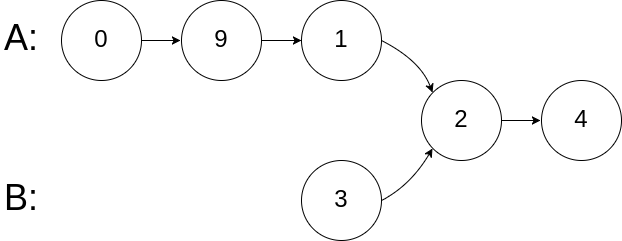复制带随机指针的链表
给定一个链表,每个节点包含一个额外增加的随机指针,该指针可以指向链表中的任何节点或空节点。
要求返回这个链表的深拷贝。

输入:
{"$id":"1","next":{"$id":"2","next":null,"random":{"$ref":"2"},"val":2},"random":{"$ref":"2"},"val":1}
解释:
节点 1 的值是 1,它的下一个指针和随机指针都指向节点 2 。
节点 2 的值是 2,它的下一个指针指向 null,随机指针指向它自己。
提示:
你必须返回给定头的拷贝作为对克隆列表的引用。因为题目要求是返回的是深拷贝,所以就是按照它原本的结构,一个节点一个节点的分配空间。
需要注意的几点是:(测试驱动的开发ORZ
- random有可能是null
- random有可能指向之前的节点
/*
// Definition for a Node.
class Node {
public:
int val;
Node* next;
Node* random;
Node() {}
Node(int _val, Node* _next, Node* _random) {
val = _val;
next = _next;
random = _random;
}
};
*/
class Solution {
public:
Node* copyRandomList(Node* head) {
Node* res=new Node;
res->next=NULL;
Node* begin=head;
Node* resbegin=res;
while(begin!=NULL){
Node* temp=new Node;
temp->next=NULL;
temp->val=begin->val;
resbegin->next=temp;
resbegin=temp;
begin=begin->next;
}
begin=head;
resbegin=res->next;
while(begin!=NULL){
Node* random=begin->random;
if(random==NULL){
resbegin->random=NULL;
}
else{
Node* temp=head; //random可能指向前方
Node* restemp=res->next;
while(random!=temp){
temp=temp->next;
restemp=restemp->next;
}
resbegin->random=restemp;
}
begin=begin->next;
resbegin=resbegin->next;
}
return res->next;
}
};补充几个对链表的基本操作步骤:
参考链接:https://www.cnblogs.com/byonecry/p/4458821.html
节点的结构
struct Node{
int value;
Node * next;
};
双向链表的节点
struct DNode{
int value;
DNode * left;
DNode * right;
};
插入节点
//p节点后插入值为i的节点
void insertNode(Node *p, int i){
Node* node = new Node;
node->value = i;
node->next = p->next;
p->next = node;
}
删除节点
void deleteNode(Node *p){
p->value = p->next->value;
p->next = p->next->next;
}环形链表
示例 1:
输入:head = [3,2,0,-4], pos = 1
输出:true
解释:链表中有一个环,其尾部连接到第二个节点。
示例 2:
输入:head = [1,2], pos = 0
输出:true
解释:链表中有一个环,其尾部连接到第一个节点。
示例 3:
输入:head = [1], pos = -1
输出:false
解释:链表中没有环。
# 一遍过,令人兴奋
/**
* Definition for singly-linked list.
* struct ListNode {
* int val;
* ListNode *next;
* ListNode(int x) : val(x), next(NULL) {}
* };
*/
class Solution {
public:
//一个走一步,另一个走两步,看会不会相遇
bool hasCycle(ListNode *head) {
if(head==NULL)
return false;
ListNode *one=head;
ListNode *two=head;
do{
if(one->next==NULL||two->next==NULL||(two->next)->next==NULL)
return false;
one=one->next;
two=(two->next)->next;
}while(one!=two);
return true;
}
};相交链表
编写一个程序,找到两个单链表相交的起始节点。
如下面的两个链表:
在节点 c1 开始相交。
示例 1:
输入:intersectVal = 8, listA = [4,1,8,4,5], listB = [5,0,1,8,4,5], skipA = 2, skipB = 3
输出:Reference of the node with value = 8
输入解释:相交节点的值为 8 (注意,如果两个列表相交则不能为 0)。从各自的表头开始算起,链表 A 为 [4,1,8,4,5],链表 B 为 [5,0,1,8,4,5]。在 A 中,相交节点前有 2 个节点;在 B 中,相交节点前有 3 个节点。
示例 2:
输入:intersectVal = 2, listA = [0,9,1,2,4], listB = [3,2,4], skipA = 3, skipB = 1
输出:Reference of the node with value = 2
输入解释:相交节点的值为 2 (注意,如果两个列表相交则不能为 0)。从各自的表头开始算起,链表 A 为 [0,9,1,2,4],链表 B 为 [3,2,4]。在 A 中,相交节点前有 3 个节点;在 B 中,相交节点前有 1 个节点。
示例 3:
输入:intersectVal = 0, listA = [2,6,4], listB = [1,5], skipA = 3, skipB = 2
输出:null
输入解释:从各自的表头开始算起,链表 A 为 [2,6,4],链表 B 为 [1,5]。由于这两个链表不相交,所以 intersectVal 必须为 0,而 skipA 和 skipB 可以是任意值。
解释:这两个链表不相交,因此返回 null。
注意:
- 如果两个链表没有交点,返回
null. - 在返回结果后,两个链表仍须保持原有的结构。
- 可假定整个链表结构中没有循环。
- 程序尽量满足 O(n) 时间复杂度,且仅用 O(1) 内存。
/**
* Definition for singly-linked list.
* struct ListNode {
* int val;
* ListNode *next;
* ListNode(int x) : val(x), next(NULL) {}
* };
*/
class Solution {
public:
ListNode *getIntersectionNode(ListNode *headA, ListNode *headB) {
int lena=getLen(headA);
int lenb=getLen(headB);
if(lena>lenb){
int temp=lena-lenb;
while(temp!=0){
headA=headA->next;
temp--;
}
}else{
int temp=lenb-lena;
while(temp!=0){
headB=headB->next;
temp--;
}
}
if(headA==NULL||headB==NULL){
return NULL;
}
else{
while(headA!=headB||headA==NULL||headB==NULL){
if(headA==NULL||headB==NULL){
return NULL;
}
else{
headA=headA->next;
headB=headB->next;
}
}
return headA;
}
}
int getLen(ListNode *head){
int len=0;
while(head!=NULL){
len++;
head=head->next;
}
return len;
}
};反转链表
反转一个单链表。
示例:
输入: 1->2->3->4->5->NULL
输出: 5->4->3->2->1->NULL进阶:
你可以迭代或递归地反转链表。你能否用两种方法解决这道题?
/**
* Definition for singly-linked list.
* struct ListNode {
* int val;
* ListNode *next;
* ListNode(int x) : val(x), next(NULL) {}
* };
*/
class Solution {
public:
ListNode* reverseList(ListNode* head) {
if(head==NULL||head->next==NULL)
return head;
ListNode* nil=head;
while(nil->next!=NULL){
nil=nil->next;
}
while(head!=nil){
ListNode* temp=head->next;
head->next=nil->next;
nil->next=head;
head=temp;
}
return nil;
}
};在网上看到另一种解法,很巧妙了
/**
* Definition for singly-linked list.
* struct ListNode {
* int val;
* ListNode *next;
* ListNode(int x) : val(x), next(NULL) {}
* };
*/
class Solution {
public:
ListNode* reverseList(ListNode* head) {
if(head==NULL||head->next==NULL) return head;
ListNode* left=NULL;
ListNode* cur=head;
ListNode* right=head;
while(cur){
right=cur->next;
cur->next=left;
left=cur;
cur=right;
}
return left;
}
};回文链表
请判断一个链表是否为回文链表。
示例 1:
输入: 1->2
输出: false示例 2:
输入: 1->2->2->1
输出: true进阶:
你能否用 O(n) 时间复杂度和 O(1) 空间复杂度解决此题?
/**
* Definition for singly-linked list.
* struct ListNode {
* int val;
* ListNode *next;
* ListNode(int x) : val(x), next(NULL) {}
* };
*/
class Solution {
public:
bool isPalindrome(ListNode* head) {
//判断回文时主要需要解决的是链表不能随机访问
if(head==NULL||head->next==NULL){
return true;
}
vector<int> array;
while(head!=NULL){
array.push_back(head->val);
head=head->next;
}
int left=0;
int right=array.size()-1;
while(left<=right){
if(array[left]!=array[right])
return false;
else{
left++;
right--;
}
}
return true;
}
};进阶自己没想出来,借助数组来完成的。
删除链表中的节点
请编写一个函数,使其可以删除某个链表中给定的(非末尾)节点,你将只被给定要求被删除的节点。
现有一个链表 -- head = [4,5,1,9],它可以表示为:

示例 1:
输入: head = [4,5,1,9], node = 5 输出: [4,1,9] 解释: 给定你链表中值为 5 的第二个节点,那么在调用了你的函数之后,该链表应变为 4 -> 1 -> 9.
示例 2:
输入: head = [4,5,1,9], node = 1 输出: [4,5,9] 解释: 给定你链表中值为 1 的第三个节点,那么在调用了你的函数之后,该链表应变为 4 -> 5 -> 9.
说明:
- 链表至少包含两个节点。
- 链表中所有节点的值都是唯一的。
- 给定的节点为非末尾节点并且一定是链表中的一个有效节点。
- 不要从你的函数中返回任何结果。
###这道题目真的是看了很久都没有理解是什么意思,没有给头结点,那要怎么删除??!!在看了其他的解答之后才明白,是删除给定的节点。
但是函数怎么调用啊,还是不明白orz
/**
* Definition for singly-linked list.
* struct ListNode {
* int val;
* ListNode *next;
* ListNode(int x) : val(x), next(NULL) {}
* };
*/
class Solution {
public:
void deleteNode(ListNode* node) {
node->val=(node->next)->val;
node->next=(node->next)->next;
}
};

























 210
210











 被折叠的 条评论
为什么被折叠?
被折叠的 条评论
为什么被折叠?








